Anthracnose of mango
Host: Mango (Mangifera indica L.)
Pathogen: Colletotrichum gloeosporioides Penz.
Pathogen: Colletotrichum gloeosporioides Penz.
Distribution
Anthracnose of mango is distributed throughout the tropical and subtropical countries of the world. The disease is reported from Australia, Asia, Europe, Africa, the Caribbean, North, Central and South America. In India the disease is prevalent in the mango growing states.
Symptoms
Symptoms of the disease occur on leaves (spots), petioles, branches (blight), inflorescence (panicles) and fruits (rot). Infected leaves show tan to dark brown colored spots at the margins. In young bronze and pale green leaves semi-circular lesions appear. The lesion eventually drop-out of the leaves. In old leaves spots appear as charcoal and leaves become curled.
Infected fruits develop dark-brown to black spots, which grow larger and coalesce. These spots may penetrate deeper into the fruit tissues and cause rotting. Premature dropping of fruit may occur. The symptoms on the infected green fruit are not visible until the ripening. A peculiar symptom of the disease is the several linear necrotic black colored regions (tear-stain), which are marked by the cracking of epidermis, giving alligator skin appearance.
The disease is favored by the wet, humid and warm weather conditions.
 |
| Mango leaves showing anthracnose disease |
The disease is favored by the wet, humid and warm weather conditions.
Pathogen
Anthracnose of mango is caused by the ubiquitous fungus Colletotrichum gloeosporioides Penz and Sacc. Its perfect stage (telomorph) is Glomerella cingulata var minor. This pathogen is also responsible for the "anthracnoses" on the tropical fruits including, chili, papaya, banana, coffee, etc. The pathogen multiply by producing numerous spores (conidia), which on splashing by rain or through irrigation water reach the healthy area and spread the infection. Conidia formation is favored by wet, humid and warm weather conditions making disease devastating.
Infected areas of the leaves are attacked by a number of secondary pathogens including, Fusarium, alternaria, curvularia, etc.
Infected areas of the leaves are attacked by a number of secondary pathogens including, Fusarium, alternaria, curvularia, etc.
Management
Anthracnose of mango is of very common occurrence in areas of wet and warm environments. It becomes devastating in the areas of high rainfall, where it is very hard to control. Integration of cultural practices, biological control and use of fungicides reduce the infection.
- Pruning and field-sanitation is necessary. In order to reduce the humidity, prune the branches every year to allow air passage through the branches and remove any debris found in the vicinity.
- Infected branches should be removed and burnt.
- Foliar anthracnose can be controlled by spraying 1.0 % Bordeaux Mixture or 0.1 % Carbendazim (50WP) every 14-20 days.
- Above fungicide should be sprayed 4-5 times since the first appearance of panicle up to the development of fruits.
- Post-harvest rotting of fruit can be controlled by dipping into the carbendazim or in hot water (52 °C) for 5 minutes.
Mango malfomration
Host: Mango (Mangifera indica L.)
Pathogen: Fusarium subglutinans Wollenw. & Reinking
Pathogen: Fusarium subglutinans Wollenw. & Reinking
Distribution
Mango malformation disease was first reported by Marries from Darbhanga district
of Bihar, India. Since then, it is of common occurrence in the tropical and
subtropical countries of the world including India, Pakistan, Bangladesh, Myanmar,
Philippines, Malaysia, Oman, Sudan, Egypt, America, Cuba, Mexico, Brazil (Kumar
et al., 2011). In India, it causes heavy economic loss in all the mango growing
states. The disease causes 50 to 60 % loss in yield (Kumar et al., 2011).
Symptoms
 |
 |
| 'Bunchy top' branch of mango tree | Malformed branches of mango |
Mango malformation
disease affects saplings in nurseries as well as mango trees. In mango trees,
both vegetative as well as floral meristems are affected. Affected young
sapling produces small scaly leaves with ‘bunchy top’ appearance of the apex.
This causes loss in apical dominance and plantlets remain stunted.
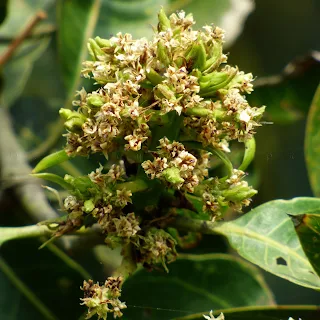 |
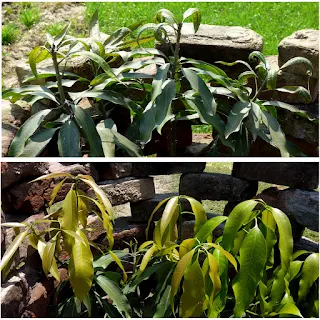 |
| Malformed inflorescence of mango | Diseases plant (upper), After treatment (lower) |
In big trees excessive
branches of limited growth arise. These branches are with short and swollen internodes
giving ‘witches' broom’ appearance. Malformation ceases the growth of vegetative
branches.
Floral malformation affects the panicles (inflorescences). The branches of the panicles become short, thickened and hypertrophied. Flowers in infected panicles are numerous and remain unopened. These are compact and crowded. Malformed panicle dries up in black mass and persists for a long time.
Floral malformation affects the panicles (inflorescences). The branches of the panicles become short, thickened and hypertrophied. Flowers in infected panicles are numerous and remain unopened. These are compact and crowded. Malformed panicle dries up in black mass and persists for a long time.
Pathogen
Mango malformation disease is caused by Fusarium moniliforme
var. subglutinans (Syn. Fusarium subglutinans). It is
anamorph of Gibberella fujikuroi var. subglutinans.
Control measures
- Disease-free saplings should be planted.
- The diseased plants should be destroyed.
- If disease appears in the branch, the branch should be pruned 10-15 cm below the infection.
- Mango malformation disease can be controlled by the spray of systemic fungicide, Carbendazim (0.1%).
- Spray of 0.2 % Captafol also controls the disease, but because of being highly toxic to fishes and other aquatic organisms, it is no longer approved in several countries (NCBI, CID=17038).
References
- Kumar, P., Misra, A.K. and Modi, D.R., 2011. Current status of mango malformation in India. Asian Journal of Plant Sciences, 10(1), p.1.
- National Center for Biotechnology Information. PubChem Database. Captafol, CID=17038, https://pubchem.ncbi.nlm.nih.gov/compound/Captafol (accessed on Apr. 17, 2020).
Red rust of mango
Algal leaf spot of mango
Host: Mango (Mangifera indica L.)
Pathogen:Cephaleuros virescens Kunze (Green alga)
Pathogen:Cephaleuros virescens Kunze (Green alga)
Distribution
Red rust of mango occurs in all the mango growing tropical and subtropical region (between 32° N and 32° S) of the world, where temperature and humidity is favorable for the
growth of pathogen, i.e., Cephaleuros (Vasconcelos et al., 2018). In India the
disease has been widely reported from the states of Uttar Pradesh, Bihar and Karnataka.
During 1956 the disease appeared in the form of epidemic in Tarai region.
Author has observed this disease in the endemic form (during 2020) in most of
the mango-gardens of the Tarai region.
Symptoms
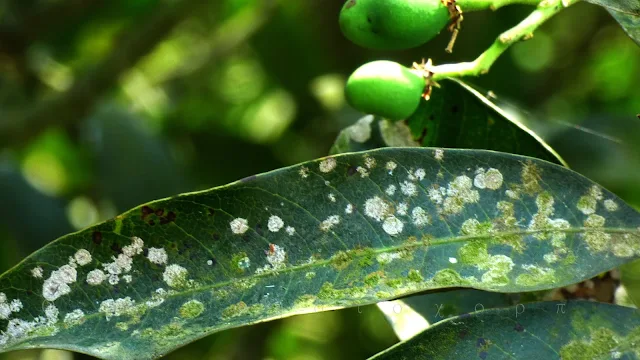 |
| Early grayish-green spot on mango leaf |
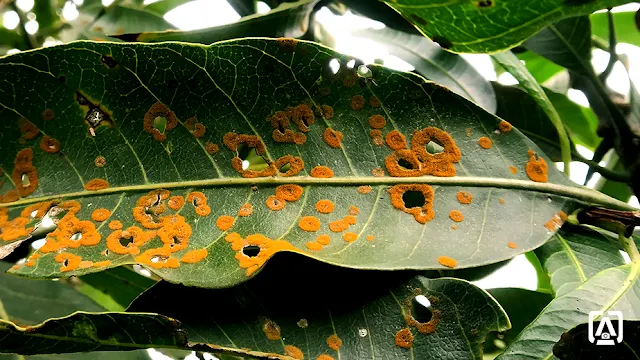 |
| Older leaf spot showing hole in the center |
Symptoms mostly appear
on the upper surface of the leaves. Initial symptoms appear as grayish-green
small spots with velvety appearance. Later spots become reddish-brown in color
giving rusty appearance (hence, red rust). Velvety appearance of the spots is due
to the numerous unbranched filaments. As disease intensified, more than one spots
coalesce to make larger spots. In older spots, the center of the spots is torn-out
in the form of holes. In affected leaves photosynthetic area is decreased, which
reduces the yield.
Pathogen
 |
| Filaments of Cephaleuros virescens on mango leaf |
Red rust of mango is caused by a green-parasitic alga Cephaleuros
virescens belonging to the family Trentepohliaceae. Vasconcelos et al. (2018) have cultured Cephaleuros
virescens in Trebouxia medium and characterized molecularly. The alga has a
broad host range including tea. Alga reproduces by producing red-colored,
ciliated zoospores in a humid atmosphere.
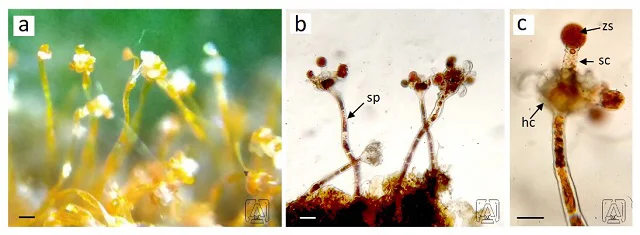 |
| Cephaleuros virescens: a: surface view under stereobionocular microscope, band c: microscopic details (sp = sporangiophore, zs = zoosporangium, sc = suffultory cell and hc = head cell). bar = μm. |
Epidemiology and Control measures
- Red rust of mango is favored by close plantation, hence close plantation should be avoided.
- Frequent rains, warm weather, poor soil drainage and stagnant air favors the growth and reproduction of Cephaleuros.
- Trees should be properly pruned and fertilized to ensure the proper aeration and growth. All the weed should be removed from time to time.
- Red rust of mango can be effectively controlled by spraying Bordeaux mixture (6:6:100 or 0.6-1.2 5).
- The disease can also be controlled by Copper oxychloride (0.25 %).
- Lichens growing on affected plants should also be removed by applying caustic soda.
References
- Vasconcelos, C.V., Pereira, F.T., Duarte, E.A.A., de Oliveira, T.A.S., Peixoto, N. and Carvalho, D.D.C., 2018. Physiological and Molecular Characterization of Cephaleuros virescens Occurring in Mango Trees. The plant pathology journal, 34(3), p.157.
Boron deficiency in mango
Symptoms
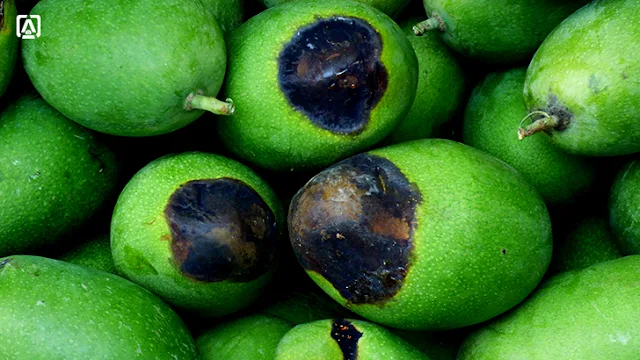 |
| Internal necrosis on mango tip |
Internal
necrosis and fruit cracking are two symptoms of B deficiency in mango. The
disease is prominent in the areas of high rainfall and temperature, acid and calcareous
soils. ‘Dashehari’ is the most sensitive to B deficiency among other cultivars
of mango (Saran and Kumar, 2011).
Internal necrosis appears initially as a dark green color area on the tip of fruits. Soon, it becomes brown with an irregular outline. In the infected area, mesocarp and seed develop necrotic tissues. Soon the necrotic mesocarpic tissues collapse and a cavity surrounded by hard tissues is formed.
Because of the abnormality in cell division and carbohydrate translocation, fruits are cracked immaturely.
Internal necrosis appears initially as a dark green color area on the tip of fruits. Soon, it becomes brown with an irregular outline. In the infected area, mesocarp and seed develop necrotic tissues. Soon the necrotic mesocarpic tissues collapse and a cavity surrounded by hard tissues is formed.
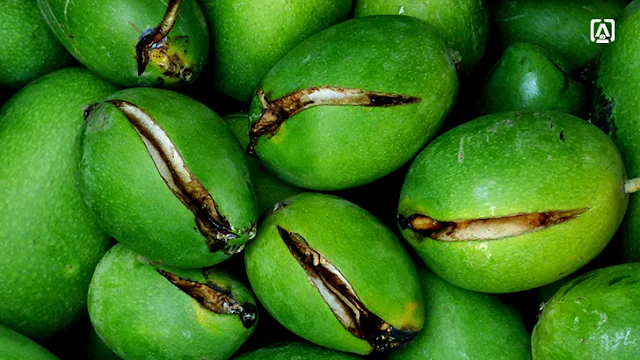 |
| Cracked mango fruits because of boron deficiency |
Because of the abnormality in cell division and carbohydrate translocation, fruits are cracked immaturely.
Management
As B is leached in the soil, it should be
applied as a foliar spray.
- B deficiency is cured by foliar spray of borax (Sodium tetraborate decahydrate).
- 5-10 kg borax should be sprayed in one hectare.
- Foliar spray of 0.10 to 0.25 % solution of borax cures the disease effectively.
References
- Saran, P.L. and Kumar, R., 2011. Boron deficiency disorders in mango (Mangifera indica): field screening, nutrient composition and amelioration by boron application. Indian Journal of Agricultural Sciences, 81(6), p.506.
Foliar gall of mango
Name of the host: Mangifera indica L.
Name of the pathogen: Mango gall midge
Name of the pathogen: Mango gall midge
Symptoms
 |
| Galls on mango leaves |
Mango midges affect mostly young developing leaves. Adult midges
lay eggs on the lower surface of mango leaves in the months of March, July and October.
The larvae invade the mango leaf and form smooth to rough, blister or wart-like,
raised gall on the upper surface of the leaves. Depending on the midge species,
more than one type of gall can occur on the same leaves. In severe
infestation, few hundred such galls are formed on a single leaf. Gall formation reduces
the photosynthetic area as well as larvae feed on the phloem sap inside the leaf,
which reduces the yield.
Insect
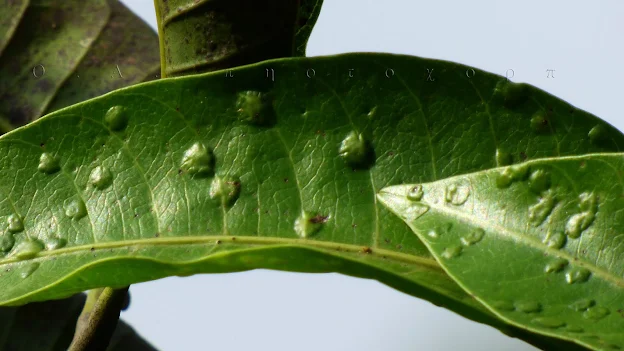 |
| Galls formed by mango midges (enlarged) |
Gall formation in mango is caused by mango midges including several species of Procontarinia. Procontarinia matteiana Keiffer
and Cecconi is common mango midge reported from Indian subcontinent, Indonesia,
Iran, Oman, Pakistan, United Arab Emirates, South Africa, Sudan Kenya,
Mauritius, Réunion. Other mango midges such as Amraemyia and Amradiplosis
echinogalliperda also cause foliar gall formation in mango in Uttar Pradesh.
Control measures
- Hand-pick the insect of population is low.
- Prune the infested branch in the season.
- Use a yellow sticky trap to catch the fly.
- Spray insecticides such as dimethoate 30 EC, methyldemeton 25 EC @ 2ml/liter, monocrotophos, bifenthrin @ 7ml/liter.
- Spray ofporfenophos 40 % + cypermethrin 4 % EC effectively controls the disease (personal observation).
- Torymus sp. and Prodecatoma sp. parasitize the larvae of mango midges.
See also
Content first created on 21-08-2020
last updated on 23-09-2024
last updated on 23-09-2024





0 Comments
Leave your comments here.